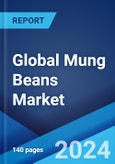Mung beans are green-colored beans belonging to the legume family, which have been cultivated and consumed in several parts of the world since ancient times. They are a rich source of fibers, vitamins, proteins, minerals, antioxidants, and phytoestrogens. Their regular consumption is known to help in preventing and controlling health issues, such as diabetes, osteoporosis, heart diseases, anemia, and cancer.
Besides this, they prevent obesity, promote digestion, reduce inflammation, lower blood pressure levels, and minimize the chances of developing chronic diseases. Mung beans are either cooked or sprouted and considered suitable for people of all ages as they are easy to digest. As a result, they are utilized in the preparation of soups, salads, stir-frys and fried snacks.
Mung Beans Market Trends
At present, there is a rise in the demand for mung beans on account of the growing health consciousness among individuals and the increasing prevalence of lifestyle diseases across the globe. Moreover, the shifting preferences of individuals from animal-based to plant-based proteins due to the rising awareness among individuals about animal health and cruelty against animals is resulting in the growing adoption of veganism and vegetarianism on a global level. Apart from this, these beans are utilized in various dietary supplements and ready-to-eat (RTE) food products. Furthermore, the burgeoning e-commerce sector and the increasing sales of mung beans via online distribution channels are propelling the growth of the market.These channels offer several advantages over offline stores, such as convenience, better price points and flexible payment and return/exchange options. Moreover, there is a rise in the number of campaigns undertaken by numerous authorities highlighting the negative impact of consuming food items prepared inorganically. This is catalyzing the demand for organic mung bean variants and offering lucrative growth opportunities to market players.
Key Market Segmentation
This report provides an analysis of the key trends in each sub-segment of the global mung beans market report, along with forecasts at the global and regional level from 2024-2032.Breakup by Region:
- India
- China
- Myanmar
- Others
Competitive Landscape
The competitive landscape of the market has been analyzed in the report, along with the detailed profiles of the major players operating in the industry.Key Questions Answered in This Report
1. What was the size of the global mung beans market in 2023?2. What is the expected growth rate of the global mung beans market during 2024-2032?
3. What are the key factors driving the global mung beans market?
4. What has been the impact of COVID-19 on the global mung beans market?
5. What are the key regions in the global mung beans market?
Table of Contents
Methodology

LOADING...
Table Information
| Report Attribute | Details |
|---|---|
| No. of Pages | 140 |
| Published | April 2024 |
| Forecast Period | 2023 - 2032 |
| Estimated Market Value ( USD | $ 4.36 Billion |
| Forecasted Market Value ( USD | $ 5.7 Billion |
| Compound Annual Growth Rate | 3.0% |
| Regions Covered | Global |









